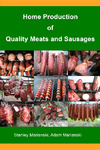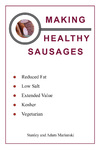Meats and Sausages
Freezing Meat
To understand the concept of freezing, it is necessary to remember that the meat consists of up to 75% of water. When water is placed in a freezer, it freezes and increases in volume.

A bottle of water is placed in a freezer. Water becomes ice and expands by about 10%.

Expanding ice puts pressure on the bottle and ruptures the glass. The ice remains in one solid block, but the glass is shattered into pieces, although it still clings to the ice.
The same applies to meat – it contains water everywhere,: inside the muscle cells, in sarcoplasm, in connective tissues of membranes, and in smaller amounts in fats.
The water inside of the meat, like the water inside of a bottle, when frozen, becomes ice. Because of its increased volume, it will expand and damage the meat protein, resulting in a loss of elasticity and its ability to hold water. How much damage is created depends directly on the temperature and speed of freezing.

When freezing is slow, water molecules that get frozen first are the ones that reside between individual muscle fibers. Water inside cells contains more salt, it is under higher pressure and lower temperature. As a result, water molecules leave muscle cells and diffuse towards connective tissues. Crystals grow larger, mainly outside the cells, and damage the structure of the meat, including its membranes.

With rapid freezing at very low temperatures, water has no time to leave cells and move into lower-pressure areas. Freezing is almost instantaneous; the formed ice crystals are very small, and there is no damage to the internal meat structure. The tiny crystals form inside and outside the cells, and water in myofibrils is the last to freeze.
It shall be noted that the curing process progresses somewhat faster in previously frozen meat due to the disrupted cell structure previously damaged by ice crystals. Meat freezes at 28° F (-2° C), but to freeze all water present inside of the meat, we have to create temperatures of -8°-22° F (-22°-30° C), which is well beyond the range of a home refrigerator. The temperature of a home freezer is set to 0° F (-18° C), which fits into the slow freezing process described earlier. A butcher’s freezer -25° F (-32° C) is more effective, but an industrial unit is needed to freeze the meat. Such units freeze meat by blasting fast-moving cold air over the product, dropping the temperature to -40° F (-40° C).
Freezing prevents the spoilage of sausage; however, keeping it in a freezer for longer than 6 weeks will lower its flavor, though it will still be nutritious and safe to eat. Fish contain more water than other meats, so its cells are more susceptible to damage by ice crystals. This means it is wiser not to freeze fish that would be subsequently cold-smoked, such as cold-smoked salmon, which is usually thinly sliced.
The curing process progresses somewhat easier in meat that was previously frozen due to a swollen and ruptured structure of meat cells, which creates an easier path for the salt to follow.
| Storage time of some meats | ||
|---|---|---|
| Method | Refrigerated at: 28-32° F (-1.5-0° C) | Frozen at: -22° F (-30° C) |
| Pork halves | 1-2 weeks | 12 months |
| Beef quarters | 4-5 weeks | 18 months |
Color of Frozen Meat
The color of frozen meat depends on the size of the crystals that form during freezing. A fast freezing rate creates small ice crystals that scatter most light, leaving the meat looking opaque and pale. Of course, the color of the meat is influenced by the species and the amount of myoglobin they carry. In frozen meat, light accelerates discoloration. Meats kept in the freezer should, therefore, be covered.
Freezer Burn
Freezer burn is the appearance problem affecting frozen meat. The problem occurs in unwrapped or poorly covered meat stored at low humidity. Such meat starts to dry out fast, leaving an unattractive spongy layer. Therefore, meat kept in the freezer should be covered as a precaution against freezer burn.

















